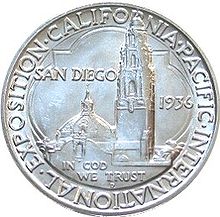United States | |
| Value | 50 cents (0.50 US dollars) |
|---|---|
| Mass | 12.5 g |
| Diameter | 30.61 mm (1.20 in) |
| Thickness | 2.15 mm (0.08 in) |
| Edge | Reeded |
| Composition |
|
| Silver | 0.36169 troy oz |
| Years of minting | 1935–1936 |
| Mintage | 1935-S: 250,132 including 132 pieces for the Assay Commission, 180,000 melted 1936-D: 180,092 including 92 assay coins, 150,000 melted |
| Mint marks | S (all 1935 coins), D (all 1936 coins). Beneath the letter T beginning TRUST on the reverse |
| Obverse | |
 | |
| Design | Minerva and other elements of the Seal of California |
| Designer | Robert Ingersoll Aitken |
| Design date | 1935 |
| Reverse | |
 | |
| Design | California Tower and Chapel of St. Francis, Balboa Park, San Diego |
| Designer | Robert Ingersoll Aitken |
| Design date | 1935 |
The California Pacific International Exposition half dollar, sometimes called the California Pacific half dollar or the San Diego half dollar, is a commemorative fifty-cent piece struck by the United States Bureau of the Mint in 1935 and 1936. Robert Ingersoll Aitken designed the coin. Its obverse depicts Minerva and other elements of the Seal of California; the reverse shows buildings from the California Pacific International Exposition (held 1935–1936), which the coin was issued to honor.
Legislation for the half dollar moved through Congress without opposition in early 1935, and Aitken was hired to design it. Once his creation was approved, the San Francisco Mint produced 250,000 coins, but expected sales did not materialize. Left with more than 180,000 pieces they could not sell, the Exposition Commission went back to Congress for further legislation so it could return the unsold pieces and have new coins, dated 1936, hoping for greater sales in the second year of the fair's run. Although the commission was successful in getting the legislation passed, it was less so in selling the coins, and 150,000 1936-dated pieces were returned to the Mint. The coins, of either date, sell in the low hundreds of dollars today.